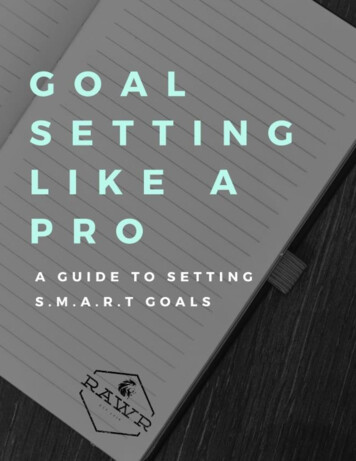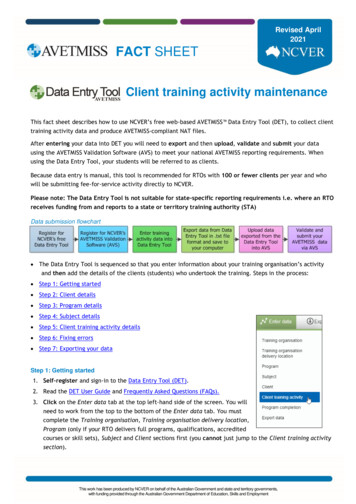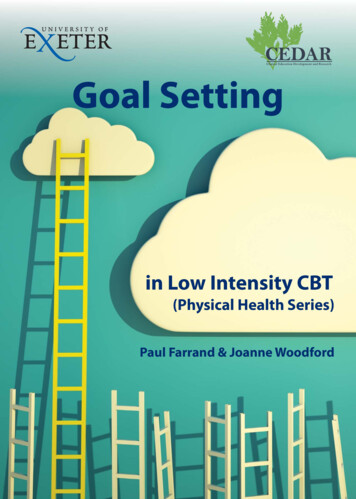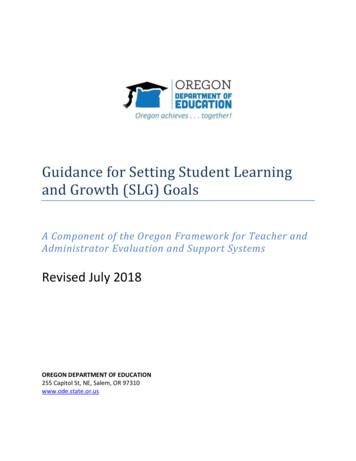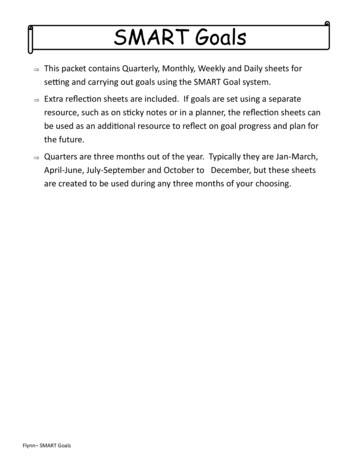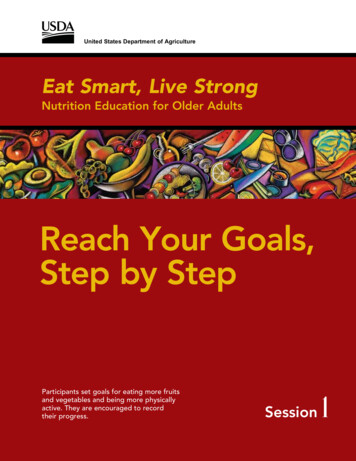
Transcription
United States Department of AgricultureEat Smart, Live StrongNutrition Education for Older AdultsReach Your Goals,Step by StepParticipants set goals for eating more fruitsand vegetables and being more physicallyactive. They are encouraged to recordtheir progress.Session1
1Welcome!SessionWelcome to Eat Smart, Live Strong. This is one of four fun, social, andinteractive sessions. The Eat Smart, Live Strong sessions are designed tohelp older adults adopt two behaviors that may improve their health andoverall well-being. The two behaviors are:1 Eat at least 31/2 cups of fruits and vegetables every day(11/2 cups of fruit and 2 cups of vegetables)2 Participate in at least 30 minutes of moderate-intensity physicalactivity most daysEach session guide includes a handout thatdescribes four exercises. With an extra10 minutes before and after each session,you may choose to lead participants inthese exercises as a “warm-up” and a“cool-down.”The four sessions in this kit are:1 Reach Your Goals, Step by StepSession 2 Challenges and SolutionsSession 3 Colorful and Classic FavoritesSession 4 Eat Smart, Spend LessSessionEnjoy!Each session is designed to address specificways to help participants adopt the behaviors.To learn more about the behaviors pleasesee the Eat Smart, Live Strong Leader’sGuide. The Leader’s Guide also providesinformation about encouraging Eat Smart,Live Strong behaviors in the context of ahealthy diet.You can use the session guides “as is”or tailor them to meet your group’s needs.Refer to the Leader’s Guide for tips onadjusting the session to meet the needs ofyour audience. The sessions are designedto flow nicely together, each sessionfurther reinforcing the key behavioralmessages. However, you can use thesessions as stand-alone pieces if youdo not have the opportunity to provideall four.The sessions are meant to be fun for you – the group leader – and for the participants.
Session1Reach Your Goals, Step by StepObjectives for Session 1Participants will be able to:n escribe three benefits of eating at leastD11/2 cups of fruits and 2 cups of vegetablesevery day.n Describethree benefits of participatingin at least 30 minutes of moderateintensity physical activity on most daysof the week.n Statetheir goal for eating more fruitsand vegetables and how they plan tomeet the goal.n Statetheir physical activity goal and howthey plan to meet the goal.Session Overviewn Participantshave a chance to practicefour simple exercises in an optional10-minute physical activity “warm-up.”nIn the session: The group discusses the twobehaviors and their benefits. Participants view examples of 1 cupportions of fruits and vegetables. In a food and exercise recall,participants assess their currentbehaviors by counting how manycups of fruits and vegetables theyate and how many minutes theywere physically active. Participants set goals for eating morefruits and vegetables and for beingmore physically active during theupcoming week.Participants take home a weekly log to track progress toward their goals, andare invited to bring back the completedlog to review at the next session. The leader closes this session with abrief discussion about how to overcome challenges to meet goals.n Participantsrepeat the same four simpleexercises in an optional 10-minutephysical activity “cool-down.” Theyreceive a handout that visually depictsthe exercises so they can do them at home.How the Session Encourages Behavior ChangenGoal setting: Committing to specific, realistic goals often helps people to adopt a behavior.nTracking success: The weekly log gives participants a visual tool to track their progress.nPeer support: Knowing that others in the group are also trying to change their habitswill motivate participants.Session 1: Reach Your Goals, Step by Step1
Session1MaterialsnPens or pencils for all participantsA place to write participant responsesso all can see: large sheets of paper (flip chartpages), masking tape, and markers; ornSession chalk board and chalk; or white board and erasable markerses ild strength, atExneedrtocheislp you bu In addition toy.1are desig crease flexibilit ysical activity,ercisesThese ex balance, and in ate-intensity ph m.raereimprov inutes of mod your daily progmin30leasterciseseaths –deep br . Itthese exking 5includetamouthbynh yoursessiougserociut thetherthour exd ourougBegin yo h your nose an ing deeply ththin throug nt to keep breartais impo ssion.seexercise1Walking Continue inutesfor 2 mngle walkily whithe deepBreaart,: Eat Smout 1b2012HandNovemberReviseds as highng kneeace, raisiplWalk in Samples of fruits and vegetables,1 cup of eachn1 cup measuresin PlaceStand up nrongLive Stibleas possHandouts: Handout 1a: Set Your Goals Handout 1b: Exercises Handout 1c: How Did I DoYesterday? Handout 1d: Participant FeedbackSheetnSession 1How Did I Do Yesterday?Check the box that represents thecups of fruits you ate yesterday.Write the total number of minutes youspent doing physical activity yesterday.Some examples of moderate-intensityphysical activity are:2 cups111//22 cups1 cup11//22 cupNoneCheck the box that represents thecups of vegetables you ate yesterday. Walking briskly OtherMowing the lawnAerobicsWeight liftingJoggingDancingSwimmingStationary cyclingActive walking or runningwith grandchildren2 cups111//22 cups1 cup11//22 cupNoneTotal Cupsof Fruitsand VegetablescupsTotal minutesof physicalactivityHandout 1c: Eat Smart, Live StrongRevised November 20122United States Department of Agriculture Food and Nutrition Service Eat Smart, Live StrongminutesTurn Over
SessionPreparationSession 1for Session 1, Reach your Goals, Step by StepToday’s Date:1. How useful was the information youlearned from this session?(Mark one response.)Not at all usefulSomewhat usefulUsefulVery useful.ost daystivity mysical acvegetad Goaits andensity phmendeps of fruerate-int1Recomcuodm/ofst 3 2minutest at lea1 Ealeast 30y.e in atevery darticipattables2 Pays nextgedas) of vecup(Goalstivity ondrsonalysical acfruits anMy Pesity php(s) ofte-intencutI will eat at leastI will gederates of mominufruitscups ofkly LogMy Wee provided, write theaceIn the sp each day.edcompletCups offruitsParticipant Feedback SheetPlease take a few moments to complete this form. Return this sheet to the groupleader. Your comments will help the leader continue to improve the session.lsur GoaSet lsYoery day.bles evn1Sessio1yTuesdayMondaSundays)# of cup(s)# of cup(Cups of esvegetablofMinuteslphysicaactivityart,Eat Smout 1a:Handmber 2012ed Noves)# of cup(nutes# of mi# ofcup(s)nutes# of mis)# of cup(s)# of cup(nutes# of miayays)# of cup(nutes# of mis)# of cup(s)s)# of cup(nutes# of mi2. Are you planning to eat more fruitsand vegetables next week?(Mark one response.)YesNoI am not sureSaturd# of cup(s)# of cup(s)# of cup(uFridayThursdsdayWedneWhy or why not?tivity yoysical actes of phthe minuate andles youtaband vegeweek.s)# of cup(nutes# of mis)# of cup(nutes# of mi3. Are you planning to increase yourphysical activity next week?(Mark one response.)YesNoI am not sure4. What did you like the most aboutthis session?5. What did you like the least aboutthis session?6. How did you hear about thisEat Smart, Live Strong session?(Mark all that apply.)Supplemental NutritionAssistance Program officeFriendSenior centerPosterFlyerNewsletterPlace of worshipOther – specify7. In which programs do you participate?(Mark all that apply.)Supplemental NutritionAssistance ProgramCommodity SupplementalFood ProgramSenior Farmers’ MarketNutrition ProgramHome delivered mealsCongregate mealsFood bank or pantryThank you for participating in Eat Smart, Live Strong!Handout 1d: Eat Smart, Live StrongongLive StrRevised November 2012Revisnn Priorto the session, prepare 1 cupsamples of a variety of fruits andvegetables, each in a separate container(or use three-dimensional food models).To help you with measurements, visitthe www.ChooseMyPlate.gov site.Click on MyPlate. Click on Vegetables orFruits to learn more about “What countsas a cup?” Whenchoosing foods to sample,consider including: Foods familiar to your audience Foods that are in season and/oraffordable on a tight budget Foods that can be counted into acup, such as beans or grapes Whole, raw fruits and vegetablesthat equal about 1 cup, such asa small apple or a cucumber A variety to include canned, fresh,and frozen foods A variety of colorful fruits andvegetables Liquid or soft foods, like applesauceor orange juice, that are easy tomeasure Raw leafy greens (2 cups of rawleafy greens contain an equivalentamount of nutrients to 1 cup ofnon-leafy vegetables) fruit (a half cup of dried fruit Driedcontains an equivalent amount ofnutrients to 1 cup of non-dried fruit)n ailor Handout 1a, Set Your Goals. MakeTa blank “master” photocopy. On thismaster, fill in the dates for the current orupcoming week before making copiesfor participants.n Make1 copy of Handouts 1a, 1b, 1c,and 1d for each participant.n Arrangeroom so participants sit in asemicircle. If you will conduct theoptional physical activity segments, usestraight-back, firm chairs placed in asemicircle at least 2 feet apart.Session 1: Reach Your Goals, Step by Step3
Session1Optional Physical Activity Warm-UpIn addition to talking about the value of physical activity, you havethe option of leading participants through several simple exercises atthe beginning and end of each session.n Add10 minutes for each optional“warm-up” and “cool-down” exercisesession; they feature the same set ofexercises and the same handout is usedfor both.n Handout1b has all of the instructionsneeded to lead Session 1 exercises.n Participantswill have a chance to trythe same movements twice.n Thisrepetition, along with the handout,will give participants the skills, selfconfidence, and tools to do theseexercises on their own at home.4n Mostgroup leaders will find theexercises simple to lead.n Youdo not need to be a skilled exerciseinstructor to lead these exercises, butyou may want to try them out aheadof time so you will be comfortabledemonstrating them.n Keepin mind that you do not have touse all of the exercises presented inthis session. You may want to tailor thephysical activities to meet the needsof each group.United States Department of Agriculture Food and Nutrition Service Eat Smart, Live Strong
Session1ExercisesWalking in PlaceLeg Curlsn Explainthat these exercises can improveyour strength, balance, and flexibility.Upper Body Twistsnn Assureparticipants that most will findthese four simple exercises easy to doand many will be familiar with theexercises.n Passout Handout 1b, Session 1Exercises and ask participants to take alook at it.Tip!List the four exercises on the handout:Walking in Place Leg Curls Upper Body Twists Bicep Curls n LeadSession 1 Exercises 1-4, usingHandout 1b and directing participantsto look at the pictures.n Letthem know that if they do not feelcomfortable or have a physical conditionthat prevents them from doing any orall of the exercises, it is OKAY to sitthem out; if they feel pain, discomfort,or fatigue while exercising, they shouldnot hesitate to stop or take a break;and, if they need assistance, they shouldlet you know right away.Bicep Curlsn Demonstratethe exercises. Make sureparticipants can see you and inviteparticipants to follow along as yourepeat each exercise.nCheck whether the group is doing eachexercise correctly and help those whoappear to need additional instruction.n Besure to encourage and give positivefeedback to participants as they trythe exercises.Try Out the Exercises!Most group leaders will find these exercises simple to lead. You do not need tobe a skilled exercise instructor to lead these exercises. Try the exercises beforethe session, so you can easily describe and demonstrate them.Session 1: Reach Your Goals, Step by Step5
Session1Reach Your Goals,Step by Step1Welcome and Introductionsn Introducethe session. Let participants know that this is the firstof four sessions in the Eat Smart, Live Strong series and thattoday’s session is “Reach Your Goals, Step by Step.”n Getto know each other. Begin by introducing yourself and mentioning a personal goal you have recently set. Askparticipants to introduce themselves by stating their names andsharing a personal goal they have recently made – or reached!n et a warm and relaxed tone for the session. Let participantsSknow that you hope to learn from their experiences and thatthey may offer comments or ask questions at any time.n Statethe purpose of today’s session.1 to eat more fruits and vegetables and2 to get more physical activityn6Share the length of the session. Let people know thatthe session will take about an hour. Mention other helpfulinformation such as the location of the rest rooms, waterfountains, or exit areas.United States Department of Agriculture Food and Nutrition Service Eat Smart, Live Strong
Session21Two Important Behaviorsand Their Benefitsn xplain that the Eat Smart, Live Strong program focuses on twoEimportant behaviors. These are two actions that health expertsrecommend to improve the health and well-being of people ofall ages:1 Eat at least 31/2 cups of fruits and vegetables every day12 Participate in at least 30 minutes of moderate-intensityphysical activity most daysn11/2 cupsFruits ention that the amount of fruits and vegetables for anyMperson depends on activity level, age, and gender. Point outthat older adults should eat at least 31/2 cups each day. Oneand a half cups should be fruit. Two cups should be vegetables. 2 cups 31/2 cups ofFruits and Vegetables1Vegetables1 Based on the segment of the target audience with the lowest caloric need – sedentary women (1,600 calories per day).For older adults who are more active, recommend 2 cups of fruits and 21/2 cups of vegetables (2,000 calories per day).Session 1: Reach Your Goals, Step by Step7
Session1Reach Your Goalscontinued sk participants to name some of the benefits of eating 31/2Acups of fruits and vegetables every day. Make sure the followingare mentioned: Get some of the vitamins, minerals, and fiber needed tomaintain good health Maintain regularity Help prevent or delay the effects of chronic conditions suchas obesity, diabetes, hypertension, and heart disease Add color, taste, and variety to the dietnn sk participants to list some of the ways they can be physicallyAactive and list these on a chalk board or flip chart page whereall can see. Save this list; you will use it later in this session. Besure to include examples of moderate-intensity physical activitysuch as: Walkingbriskly Mowing thelawn Aerobicsn8 Weight liftingJoggingDancingSwimming Stationary cycling Active walkingor running withgrandchildren iscuss the benefits of engaging in 30 minutes of physicalDactivity most days. Mention the following: Help prevent or delay the effects of chronic diseaseFeel better Decrease mild stress, anxiety, and depression Build and maintain healthy bones, muscles, and joints Improve strength Increase balance and reduce the risk of falling Improve sleep United States Department of Agriculture Food and Nutrition Service Eat Smart, Live Strong
Session31Why You’re HereInvite participants to talk about the recommendations to eatmore fruits and vegetables and to exercise more. Ask: Is this something that you think you can do? Why or why not? What makes it hard for you to eat more fruits andvegetables? What makes it hard for you to get enough exercise?nn Acknowledgethat these recommendations can be a bitoverwhelming. Stress that every little bit helps. Making smallchanges – like eating a serving of fruits or vegetables as asnack instead of sweets or taking a walk around the block everyafternoon – can make a difference.n Letparticipants know they will reflect on past behavior andthink about new ways to live healthier lives.Session 1: Reach Your Goals, Step by Step9
Session1Reach Your GoalscontinuedSkills-building Activity4Be sure that everyone is seated comfortably andthat all can see you, the leader.How Did I Do Yesterday?n Prior to the session, prepare 1 cup samples of a variety offruits and vegetables, each in a separate container.nSession1ay?Yesterd tes youid I DWorite the total ysnuicambleracoftivmiitynuyesterday.How Dts thephingyspent dointensitreseny.that repthe box u ate yesterdaCheckfruits yocups ofrateof modeamplesSome ex activity are:lphysicaying briskl Walknng the law MowiicsrobAe ht lifting WeiggginJog 2 cupsing Danc111//22 cupsng1 cupSwimmi g11// cup22ry cyclinnatio Starunninglking orNoneActive wa erenthildndchresentswith grathat rep yesterday.atethe boxCheck vegetables your Othecups of Use the fruit and vegetable samples that you have measuredout ahead of time to help participants visualize what 1 cupof various fruits and vegetables looks like. Pass these samplesaround and encourage discussion, asking some of thesequestions: Which of these measures surprises you? How many (grapes, berries, carrots,green beans) are in 1 cup? How do you estimate 1 cupof fruit or vegetable?2 cups111//22 cups1 cup11// cup22NonepsTotal Cusof Fruit tablesgeand VeSmart,t 1c: EatHandou mber 2012RevisedcupsnutesTotal mi licaof physactivitytesminu1 cuperTurn OvongLive StrNoveTip!What counts as a cup of fruit?In general, 1 cup of fruit or 100% fruit juice, or half cup of dried fruit, containsthe nutrient equivalent of 1 cup of fruits. For more information please its.10United States Department of Agriculture Food and Nutrition Service Eat Smart, Live Strong
Session1 cupTip!1n et these measured samples in a place where all can see themSas they record what they ate yesterday.n ass each participant a copy of Handout 1c, How Did I DoPYesterday? Help participants use the handout to record thenumber of cups of fruits they ate yesterday. Remind peopleto think about: fresh, frozen, dried, or canned fruit packed in 100% juice orwater that were ingredients in salads, desserts, smoothies, or fruitsother mixed dishes fruits they ate at meals or as snacks 100% fruit juice Check people’s handouts to ensure they understand how tocomplete them. Have them write in the total number of cups offruits they ate yesterday.nHave participants continue to fill in the handout, recording thenumber of cups of vegetables they ate yesterday. Remindpeople to think about: fresh, frozen, or canned low-sodium vegetables that were ingredients in sandwiches, salads, vegetablessoups, casseroles, or other mixed dishes vegetables they ate at meals or as snacks 100% vegetable juiceWhat counts as a cup of vegetables?In general, 1 cup of raw or cooked vegetables or vegetable juice, or 2 cups ofraw leafy greens, contains the nutrient equivalent of 1 cup. For more informationplease visit: s.Session 1: Reach Your Goals, Step by Step11
Session1Reach Your GoalscontinuedHow Did I Do Yesterday?nShow participants where to fill in the total cups of fruits andvegetables. Make sure everyone has filled in a total.nHave participants share how many cups of fruits and vegetablesthey reported. To do this, ask everyone who ate at least 1 cupof fruits and vegetables to stand up. Ask those who ate at least2 cups to remain standing – and the others to take a seat.n12continuedRepeat for at least 3 cups and, again, for at least 31/2 cups.Point out that those who remain standing ate the minimumrecommended number of cups of fruits and vegetablesyesterday. Have the group congratulate them.nUsing the physical activity list they created earlier, have participants discuss the kinds of physical activity that raise the heart rateand breathing. Ask people to record the number of minutes theyparticipated yesterday in each type of physical activity in the liston Handout 1c.nYou may want to have a general discussion about the first itemin the handout – walking. Ask participants to stand up if theywalked yesterday. Remind them that they may have gone for awalk with a friend, walked to the store, walked up and downstairs, or walked the dog. Have participants talk aboutsome advantages of walking: no equipment needed;no cost; can be a social event; etc.nAsk those who are standing: “Howmany minutes did each of youwalk yesterday?”United States Department of Agriculture Food and Nutrition Service Eat Smart, Live Strong
Sessionn1Sessio1y?sterdaI Do YeidDHowsBenefititsps of frut 31/2 cug at leass of eatin ery day:Benefitevesblsuch astadiseasesand vegeof chronice effectsdelay th heart diseasedevent orHelp pr pertension, anhysty,ed toneboobesier needg healthys, and fibain stronmineralamins, Maintof the vit hmesotalt Ge intain good hemarityur dietain regulaty to yo Maintand varielor, taste,utes30 min Add co nHave participants who walked fill in the first blank in the list toindicate the number of minutes walked.nHave participants continue filling in the number of minutes theyparticipated yesterday in each activity. Point out that the bottomrow – “Other” – allows them to write in a physical activity not onthe list. Have everyone add up the total number of minutes theyexercised yesterday and write the total at the bottom of the chart.nHave participants report on the number of minutes they exercisedthe previous day. To do this, ask all participants to stand up.Have everyone who exercised less than 10 minutes yesterdaysit down. Continue for less than 20 minutes and less than 30minutes. Those who were physically active for 30 minutes or morewill remain standing. Have the group congratulate them.leasting in atrticipat t days:s of paBenefitity mosical activdiseaseof physchronic o they practice using the log.nEncourage them to keep it in a visible place in their home,such as the refrigerator so that they remember to record theirprogress.nIf you will meet again with this group of participants forSessions 2, 3, or 4, let them know the time and date of thenext meeting. Ask participants to bring their weekly logs to thenext session, so they can report on their progress. You mayneed to remind participants prior to the next session.“What if I have a serious health condition?”Members of your group may be concerned about eating certain fruits and vegetables orparticipating in physical activity if they have health problems. Suggest that participantsdiscuss their concerns with a health care provider. Point out that everyone can benefitfrom eating some types of fruits and vegetables and regular physical activity.16United States Department of Agriculture Food and Nutrition Service Eat Smart, Live Strong
Session1Challenges to Reaching the GoalsnAsk participants to talk about the challenges they might face inreaching their goals. Other participants may offer suggestionsfor overcoming the challenges.nDepending on the challenges mentioned, briefly discuss someof the obstacles that older adults face. Have participants suggestways to overcome challenges such as: Difficulty chewing fruits and vegetables: choose canned fruitpacked in 100% juice or water; cook vegetables until soft Trouble handling a knife to pare or cut up fruits andvegetables: choose canned or frozen fruits and vegetablesthat tend to be bite sized Lack of transportation for frequent shopping trips: use acommunity van service; go grocery shopping with a friend;ask a family member for helpnOlder, low-income adults report that the high cost of fruits andvegetables makes it hard for them to eat 31/2 cups every day.Ask participants to share ideas about how to eat more fruitsand vegetables on a limited budget. Be sure to mention thefollowing tips during the discussion: Participate in the Supplemental Nutrition Assistance Program. Enroll in the Senior Farmers’ Market Program, if available. Choose produce in season. Use food distribution programs, such as food banks orfood pantries. dried, frozen, or canned fruits and vegetables when Purchasethey are on sale. Participants enrolled in the Supplemental Nutrition AssistanceProgram can use their benefits to purchase seeds and grow afruit and vegetable garden.Session 1: Reach Your Goals, Step by Step17
Session1Reach Your GoalscontinuedChallenges to Reaching the Goalscontinuedn Offer to talk after the session with participants who would likehelp in finding some of the program resources mentioned.n One of the biggest challenges for keeping physically activeis time. Have participants think of ways they can be morephysically active in their daily routines, such as: Park the car a bit farther from the store or office you are nvisiting so that you must walk farther. Climb the stairs instead of taking the elevator. When a friend comes to visit, suggest that you walk and talk. While caring for young children, join in some of their activegames such as tag, hopscotch, and running.Instead of watching TV, turn on the radio and dance aroundthe house! If you will be providing additional sessions, tell participantsthat Sessions 2 and 4 will address additional challenges andsolutions.18United States Department of Agriculture Food and Nutrition Service Eat Smart, Live Strong
Session51Wrap Upn Recap the main point of this session: the value of setting goalsin order to eat more fruits and vegetables and to be morephysically active. Invite participants to say some encouragingwords that may help themselves and others in the group to tryto meet their newly set goals.n Thank participants for joining the session and invite them to thenext session, letting them know the time and place.n1Sessioetck SheeeStdepbbyaStepFtnaip h your Goals,Parsstioicace groupn 1, Reeet to ththis shfor Sesession. Returnimprove thetothis formmplete der continuets to coleamomenwill help thewfeatsabouttakee leastPlease Your commenu like thleader.t did yo5. Wha ssion?te:Daseuy’sisyot
affordable on a tight budget Foods that can be counted into a cup, such as beans or grapes Whole, raw fruits and vegetables that equal about 1 cup, such as a small apple or a cucumber A variety to include canned, fresh, and frozen foods A variety of colorful fruits and vegetables Session

